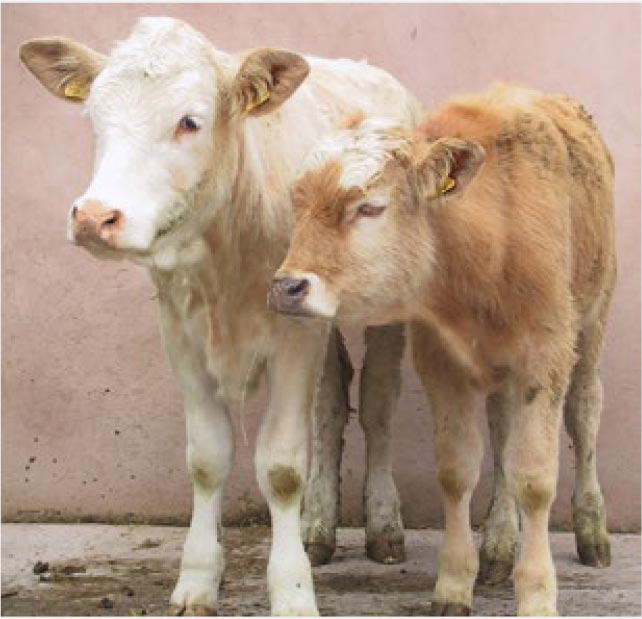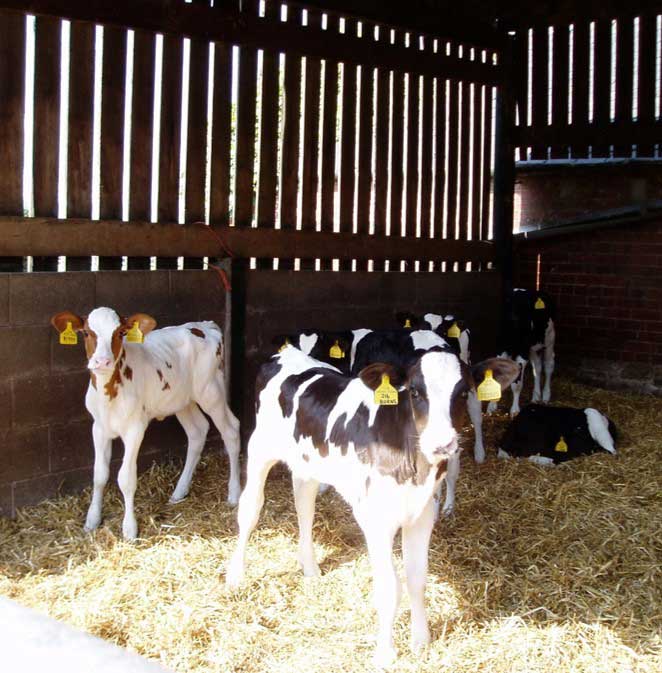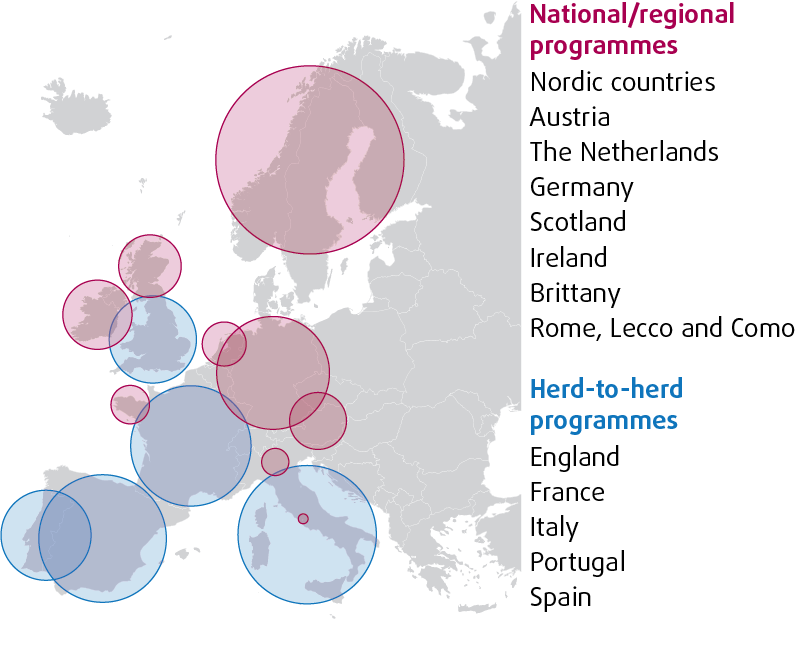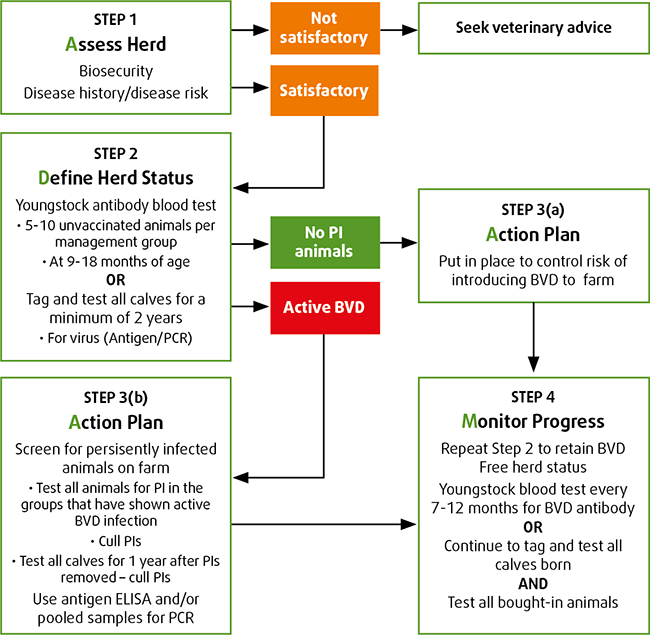11 Feb 2020

The year 2016 saw the launch of BVDFree England – a voluntary, industry-led scheme working to eliminate bovine viral diarrhoea (BVD) from all cattle in England by 2022. In June 2018, the BVD Stamp It Out initiative was launched, injecting £5.7 million into eradication in England. Using Rural Development Programme for England funding – secured until the end of 2020 – it aims to engage 50% of the breeding herd by working with local veterinary practices seeking to offer this funding to clients.
BVD is cited as being the third most economically devastating disease in the dairy industry after mastitis and lameness. It is thought to cost the cattle industry in the UK up to £61 million a year. UK farming faces increasing pressure from the consumer to improve efficiency, reduce medicine usage and further improve animal welfare.
A disease that affects far more than the persistently infected animal, by removing BVD from the UK herd, we stand to go a long way in improving cow fertility, productivity, and calf health and welfare in both the dairy and beef sectors.
A pestivirus of high genetic variability (others include classical swine fever and border disease of sheep), first reports (1953) of bovine viral diarrhoea (BVD) were of an acute, highly infectious diarrhoea where most animals recovered quickly, although 4% to 8% died of mucosal disease.
These days, practitioners would generally accept diarrhoea as being a less common presentation, with fertility issues and calf health more often flagging up questions over BVD status of a herd.
As early as 1956, abortions were found to be a consistent finding in herds with disease outbreak, with transplacental infection demonstrated in the 1970s. It is these presentations of disease that lead to massive economic disruption on a farm, poor fertility and production in cows, and a weakened immune function in the calf.
Non-pregnant animals encountering the disease will not suffer marked clinical disease. What may present are pyrexia, leukopenia from days 3 to 7 and limited recovery of the virus from nasal secretions during the first 3 to 10 days. The immune suppressive effects make them more susceptible to other infections, such as pneumonia and enteric disease, and links have been made to increased incidence of TB in the herd affected by BVD.
In the adult cow, you may see milk drop or scour and reproductive losses. In the calf with dual infections (BVD plus pneumonia/scours), more significant morbidity and mortality will likely exist. The importance of these transient infections can not be underestimated, however, as they are responsible for 93% of all in utero infections that result in the birth of persistently infected (PI) calves.
In utero infection of the calf leads to quite different outcomes, described in detail elsewhere (Figure 1). Early infection may lead to abortion, fetal reabsorption or stillbirth. Very late on infection (six months gestation-plus) may result in a normal calf. Calves infected early mid-pregnancy may develop congenital defects of neurological or limb deformities.

The crucially important subset of calves are infected before immunocompetence has developed (approximately 120 days), but survive to birth and may well reach full adulthood. They are demonstrated to be immunotolerant to the virus, not producing antibodies and effectively being PI calves. It is these calves that could go on to develop mucosal disease, and are pivotal in spread and control of the disease (Figures 2a and 2b).


Maintenance and propagation in a herd is by the PI animal, which effectively acts as a super shedder, excreting 1,000 times more virus in bodily secretions compared to a transiently infected animal.
Experiments show BVD virus (BVDV) environmental survival is dependent on temperature and moisture levels, with a maximum survival in bovine farm slurry at 5°C for three weeks and at 20°C for three days. Anecdotal and experimental reports exist of indirect BVDV transmission from contaminated pens, rectal examination gloves, hypodermic needles, nose tong, and ambient air. One tube of PI blood diluted with 700L of water has been found to be still infectious1-3.
Two distinct species of BVDV pertain mostly to the geographical distribution of the virus. BVDV-1a to BVDV-1n have a worldwide distribution, with the majority of isolates found in the UK belonging to the BVDV-1a group. BVDV2 viruses were historically restricted to US and Canada, though it was known to be active in the UK in 2007. More recent studies have failed to identify it actively circulating in the UK. However, with international movements of cattle, it remains a significant risk to the UK cattle population4.
Further to this, two distinct biotypes exist for each species of BVDV – the non-cytopathic, which persists in the cattle population (in the form of PI animals), and the cytopathic biotype, which arises after a variety of mutation events or recombination with other BVDV strains that can go on to cause mucosal disease in the PI animal.
BVD is considered widespread in the UK, with 90% of herds showing some exposure to the virus. Estimations of the prevalence of PI animals within those herds are between 0.3% and 3%.
BVD is widespread in North America and some central European countries, whereas other countries have launched large-scale eradication schemes as far back as 1993. The Shetland Islands, Scandinavian countries, Germany and Switzerland have led the way with eradication. Despite differences in legal support and initial prevalence (1% to 50%), these countries have entered final phases of eradication after 10 years, with Switzerland and Scandinavian countries being BVD free (Figure 3)5,6.

More locally, Scotland, Ireland and Northern Ireland already have in place mandatory government-led programmes with according legislative changes focusing on compulsory testing, and trade restrictions on farms and/or animals not yet tested. Scotland entered phase 5: Enforcement in 2019.
This focused on protecting all negative herds at all costs, with comprehensive non-compliance enforcement matrices followed by local authorities.
Ireland started compulsory testing in 2013, with notification of neighbours and movement restrictions being served on identification of PI animals, until those were removed. Wales has an industry-led voluntary programme that launched July 2017.
Farms that tested positive then received funding from the Welsh Government’s Rural Development Programme to aid identification of PI animals. As of November 2019, 75% in the country have been tested, showing 28% of herds to be seropositive and finding 243 PI animals.
In 2016, England launched the voluntary industry-led BVDFree England scheme asking individual farmers to sign up to a national database where BVD statuses are easily accessible. The scheme aims to facilitate eradication by 2022. In 2019, 31 December saw 5,656 holdings registered – that is, 34.53% of total English breeding cattle. In 2018, the BVD Stamp It Out scheme was launched using £5.7 million Rural Development Programme for England funding. This seeks to engage 50% of the UK breeding herd. As of December 2019, 5,098 farms are enrolled, with 4,200 of those opting to also enrol to BVDFree England7.
If England fails to tackle BVD, the impact on exports would be inevitable. We must seek to address the perception that our lack of control on BVD, and other statutory and non-statutory diseases, leaves us a high-risk prospect for livestock trade (Panel 1).
BVD sits in a pretty good position for the keen vet and committed farmer. We have reliable, affordable tests for antibody surveillance (exposure) and antigen hunts (infection). We also have safe and effective vaccines to bolster the protection of a herd when we are faced with biosecurity concerns.
Eradication at herd level can be achieved with commitment from farmer and vet alike, in as little as two years. BVDFree England and the BVD Stamp It Out scheme draw on common principles of disease control (Figure 4).

Antibody ELISA tests will give an idea of whether the group of animals has been exposed to BVDV. This can be done as a youngstock screen of 9-month-old to 15-month-old animals – 5 to 10 from each management group on individual bloods (serum). It is important that every management group is tested, taking into account nose-to-nose contact and shared airspace of at least two months. For further advice regarding group sampling, visit https://bit.ly/2OrrX3Y
Bulk milk antibody surveillance can be a useful adjunct, but is not recognised for robust definition of herd status and requires careful interpretation8.
Another option is antigen tests – where an antibody response shows exposure then the aim is to identify the source of infection. Tag and test represents affordable, easy (farmers can do it) individual tissue PCR antigen testing (Figure 5). Tags can be used as management tags or to include mandatory identification numbers. When used as whole herd surveillance, all calves (including stillborns) should be tagged as soon as possible after birth to reduce identification of circulation transient infection. This is unaffected by maternally derived antibody.

A bulk milk PCR antigen (sensitive enough to identify 1 PI animal out of 300 milking animals) test will show if virus is actively secreted into the bulk tank. It is a useful and inexpensive test, but it must be remembered it offers only a snapshot of those cows contributing that day. Also, false positives may occur with modified live vaccination within four weeks of vaccinaton. Consult your lab for exact numbers for confidence.
Individual blood antigen tests available include PCR and antigen ELISA.
Any individual viraemic on a first sample (greater than 30 days old) should, strictly speaking, be retested three weeks later as the viraemia in a transiently infected animal only lasts 10 to 14 days. Subsequent samples that test positive confirm the animal to be PI.
All PI bulls produce semen infected with BVDV. Furthermore, acute infection (transient) of the bull can result in BVDV infection of the testicular tissues and semen, which, in turn, is often of poor quality and yet has the potential to spread BVDV to seronegative heifers.
Also, in bulls it has been demonstrated that while they may mount an immune response to transient infection producing antibodies, those antibodies may not always be able to cross the testes barrier and, in one bull, virus was continuously shed in the immunocompetent non-viraemic animal9.
Normal blood screening techniques would have shown this bull to have been immune and not shedding, although he would have posed serious risk to naive heifers9.
Biosecurity forms the basis of any infectious disease plan. Increasingly, industry is seeking farmers to engage with this in a more proactive fashion. Multiple milk contracts are now seeking annual biosecurity training and reviews with vets.
Red Tractor Assurance is seeking dairy farms to have a working BVD eradication plan encompassing biosecurity. Also, a variety of accreditation schemes (for example, CHeCS, the Premium Cattle Health Scheme and HiHealth Herdcare) provide a structured framework for those beef and dairy herds to receive recognition for strict biosecurity.
In 2019, a survey of England showed that, of 62% of herds that stated they were closed, 19% bought bulls in. The same survey showed 20% of those not culling PI animals will sell them on10.
Notably, higher than anticipated retention of PI animals in the Welsh and Irish schemes has occurred, despite being unable to sell them on. Now abattoirs have volunteered to reject fattened PI animals to reduce people attempting to keep and finish them.
Recommended steps for biosecurity in a BVD control plan are:
Low-risk purchases are from herds that are accredited BVDFree England, or have negative herd status through either BVDFree England and/or BVD Stamp It Out schemes or equivalent. Also, a pregnant dam that is negative for antibody and virus, unlikely to be a Trojan animal.
High-risk purchases are from herds where a number of PI animals have been disclosed in the past 12 months, a herd that has had a non-negative result on annual screening through BVDFree England or BVD Stamp It Out schemes, or pregnant animals with no test/history.
The cost of BVD to the industry is quoted as being between up to £61 million per year. While this figure is a little startling, it may be hard to grasp the reality and, in more familiar terms, it has been estimated that this may equate to £4,500 per year for the 100-cow beef herd, or £15,000 a year for the 130-cow milking herd.
A presentation from the Centre of Expertise on Animal Disease Outbreaks Conference 2019 showed economic analysis of introduction of a PI animal into a naive herd generated a cost of £55 per cow in the beef herd and £35 per cow in the dairy herd, with abortions of up to 5.6% and milk loss of 64.5L.
Ultimately, though, the main benefits for eradicating BVD should be seen as those tangible on farm – healthier stock and healthier profits. It has been well demonstrated that, on eradicating PI animals from farm, youngstock health should improve. In eradication programmes11, calf treatments for pneumonia and scours reduced to nearly zero after all PI animals were removed. This is a further benefit in a time where farms and prescribing vets come under increasing scrutiny regarding antibiotic use. Calves that have been sick with either pneumonia or scours may never reach their full potential, and the effects can be felt right up until they produce their own calves and enter their own productive cycle.
Significant psychological stress is added to farmer, owner or farm staff where multiple health issues exist. A farm with actively circulating BVD is likely to suffer poor fertility, which will go hand in hand with poor productivity, poor output and cash flow, as well as likely having sick and dying youngstock. In turn, this is more labour intensive, and can quickly deplete the physical and mental reserves of most of our clients.
Vaccination (Table 1) has been available and widely used in the UK for more than 15 years. At one time it may have been perceived by farmers and vets alike as a cure all, without any active monitoring or PI hunting.
| Table 1. Bovine viral diarrhoea (BVD) vaccines available in the UK | |||||
|---|---|---|---|---|---|
| Product | BVD type 1 | BVD type 2 | Route | Number of injections | Booster |
| Bovilis BVD | Yes | Yes | IM | 2 doses 4 weeks apart in cattle from 8 months old at least 4 weeks prior to service. | 1 vaccine 6 months after basic vaccination, with next re-vaccinations at 12-monthly intervals. |
| Bovela | Yes | Yes | IM | 1 dose at least 3 weeks before service in cattle from 3 months old. | Annual |
| Rispoval 3 or 4 | Yes | No | IM | 2 doses 3 to 4 weeks apart from 12 weeks of age. | BVD type 1 protection lasts only up to approximately 6 months old. |
| Bovalto Respi 4 | Yes | No | SC | 2 doses 3 weeks apart from 2 weeks old. | BVD type 1 protection lasts only up to approximately 6 months old. |
This method of control cannot be seen as complete and PI animals must be sought out in an eradication programme. Also, historical use of a PI as a vaccinator animal cannot be considered an effective control policy and is outdated.
When to vaccinate? Having assessed the risks, vaccination is advisable where any potential breach in biosecurity is possible. Vaccination offers cost-effective protection of the dam, thereby eliminating the production of PI animals and propagation of disease within the herd. Considerable damage was caused in Lower Saxony, Germany, where BVDV was reintroduced to herds that had become seronegative after eradication, to the extent some state authorities now subsidise and order vaccination6.
As for all BVD vaccines, the aim is for all breeding stock to have completed their primary course 3 to 4 weeks prior to service, to ensure full fetal protection, eliminating the risk of the dam producing a PI fetus.
As with all vaccination protocols, strict adherence to manufacturers’ recommendations for storage, timing and method of delivery is critical for robust protection (Figure 6).

Failures of the vaccine to halt spread of disease have been due to incorrect timing or failure to correctly follow the primary course of two vaccines. The more recent introduction of a one-shot primary course offers protection against both BVD types 1 and 2, while having a simple administration programme for farmers to adhere to, aiding compliance.
Note while the main aim of vaccination is to halt production of future PI animals on the farm, where active infection exists, vaccination of the calves to effect protection from BVD type 1 aims to reduce the immune suppressive effect and reduce virus shedding in that population.
It is clear to see from Europe that BVD eradication schemes can be successful. While BVDFree England and BVD Stamp It Out have been launched as voluntary initiatives, a statutory requirement for all holdings to comply should follow.
It is essential that vets and farmers work together to achieve success here. Nothing can be more rewarding than improving overall herd health and providing a transparent market for trading animals.